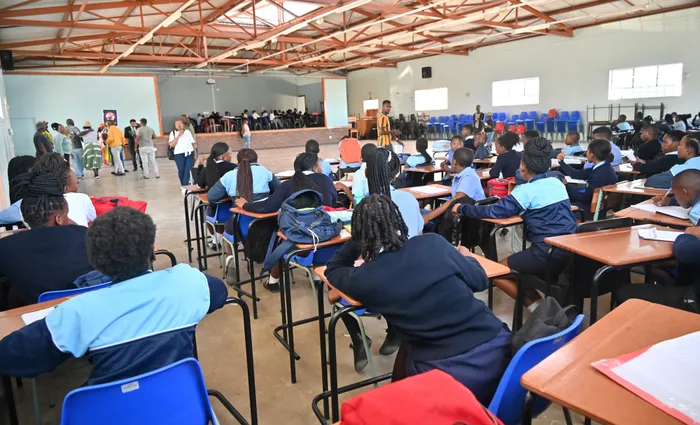‘Teacher post cuts hit poor schools hard’

Mfuleni High School is using the school hall as a class because of overcrowding. Ayanda Ndamane / Independent Newspapers
MORE than 100 Quintile 5 schools, the wealthiest, have allegedly been shielded from the recent teacher post-cuts in the province, according to research analysis the Western Cape Education (WCED) has dismissed as propaganda.
The WCED has been under the spotlight since it announced that it would not renew the contracts of 2407 teachers by the end of last year due to National Treasury-imposed budget cuts.
Opposition parties have decried this move, saying it would lead to worsening the overcrowding crisis in schools classified as quintile one.
Researcher and principal associate at Public Ethos Consulting, Dr Seelan Naidoo, said while the WCED had disclosed what schools would be affected by teacher post cuts, it did not disclose what schools were exempted and why.
Naidoo said he had been following the situation with the teacher cuts and decided to do some digging.
His methodology included using data from the department on which schools would be affected by the cuts and the Department of Basic Education (DBE) on the total list of schools in the province.
Naidoo explained that in September 2024, the WCED released a report in the provincial legislature detailing teacher cuts for 2024. The 21-page document listed public schools, their locations, WCED-funded posts, and the number of teacher contract posts being cut.
However, he said the report provided minimal data, “insufficient” for assessing the rationality or fairness of these cuts. To address this, additional data from the DBE’s 2023 schools master list was cross-referenced, “leading to significant findings”.
“I found there were 437 schools where there are no cuts. Of a total of 1,468 public schools in the Western Cape, 1,031 schools (70%) collectively suffered all 2,407 cuts of contract teacher posts and these were declared by the WCED in the legislature,” said Naidoo.
If there was fiscal pressure and posts needed to be cut, the burden would have to be distributed equitably, maintained Naidoo.
“I then wanted to know who these schools are that were exempted and why? I thought maybe it would be poorer schools from a redress point of view.”
He found exempt from the cuts included 111 Quintile 5 schools, 54 Quintile 4 schools, 55 Quintile 3 schools, 52 Quintile 2 schools and 164 Quintile 1 schools.
He then further compared these figures to show how many teachers these different quintile schools currently have and how they would be affected by teacher cuts.
The findings showed that while quintile five schools would allegedly have 723 post cuts, it would be only 8,7% of their 8 309 WCED posts. In comparison quintile 1 schools would allegedly lose 198 or 10,2% of 1 932 WCED posts.
“The cuts land more heavily on the poorest Q1 schools (10,2% of WCED posts cut; 8,8% of educators lost) than on the wealthiest Q5 schools (8,7% of WCED posts cut; 6,1% of educators lost) whether this is calculated in terms of the percentage of WCED posts lost, or in terms of the percentage of total educators lost,” he said.
Education MEC David Maynier said the formula to determine how the total number of teaching posts gets divided was provided by the national government according to personnel administration measures.
“The formula takes into account class sizes, the workload of teachers, the size of the school, language, curriculum, poverty, and other factors. Only Special Needs schools were excluded from a reduction in posts, given the nature of their teaching and learning environment.”
Maynier called the research, “propaganda masquerading as alleged research”.
“The claims made are frankly nonsensical. The author in his own report has disproved his claim that Quintile 5 schools are being shielded. He indicates that the majority of the schools that have had zero posts cut are Quintile 1, 2 and 3 (no-fee) schools, and that the quintile with the highest number of schools with zero posts cut is Quintile 1. He also indicates that the quintile with the highest number of schools with posts cut is…Quintile 5.”
Education activist Hendrick Makaneta said the impact of teacher post cuts in general would be severe on children “because it means you might find yourself with overcrowded classrooms, especially in quintile 1 schools”.
The Special Action Committee for Education (SAC) said they were outraged by the findings.
“As the SAC, we demand to know: Why were these schools exempted, and what criteria guided these decisions? Who are these schools and why was this kept away from the public?” said SAC secretary Wesley Neumann.
Cape Times